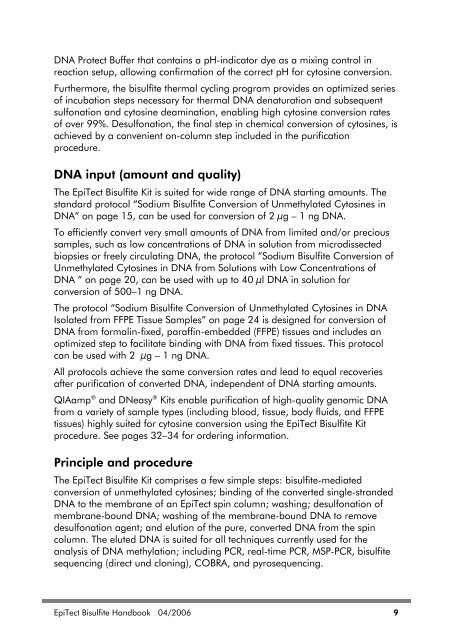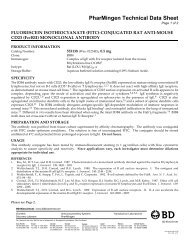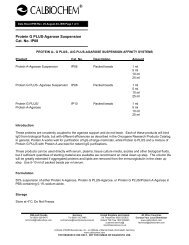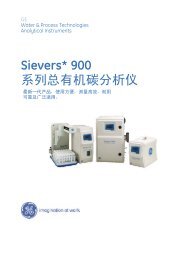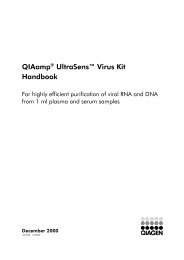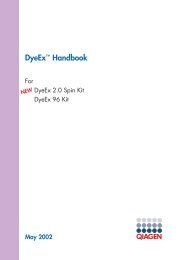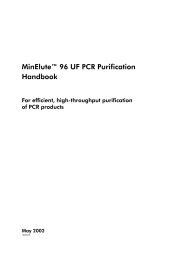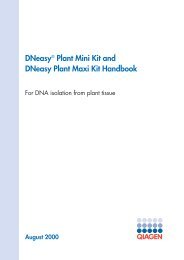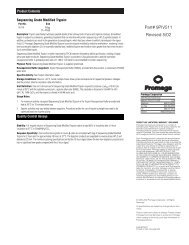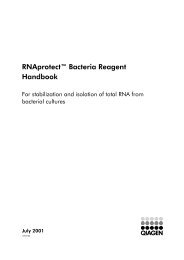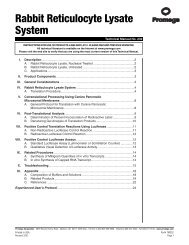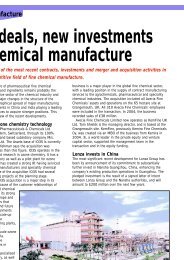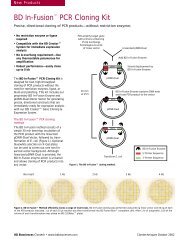EpiTect Bisulfite Handbook
EpiTect Bisulfite Handbook
EpiTect Bisulfite Handbook
Create successful ePaper yourself
Turn your PDF publications into a flip-book with our unique Google optimized e-Paper software.
DNA Protect Buffer that contains a pH-indicator dye as a mixing control in<br />
reaction setup, allowing confirmation of the correct pH for cytosine conversion.<br />
Furthermore, the bisulfite thermal cycling program provides an optimized series<br />
of incubation steps necessary for thermal DNA denaturation and subsequent<br />
sulfonation and cytosine deamination, enabling high cytosine conversion rates<br />
of over 99%. Desulfonation, the final step in chemical conversion of cytosines, is<br />
achieved by a convenient on-column step included in the purification<br />
procedure.<br />
DNA input (amount and quality)<br />
The <strong>EpiTect</strong> <strong>Bisulfite</strong> Kit is suited for wide range of DNA starting amounts. The<br />
standard protocol “Sodium <strong>Bisulfite</strong> Conversion of Unmethylated Cytosines in<br />
DNA” on page 15, can be used for conversion of 2 µg – 1 ng DNA.<br />
To efficiently convert very small amounts of DNA from limited and/or precious<br />
samples, such as low concentrations of DNA in solution from microdissected<br />
biopsies or freely circulating DNA, the protocol ”Sodium <strong>Bisulfite</strong> Conversion of<br />
Unmethylated Cytosines in DNA from Solutions with Low Concentrations of<br />
DNA ” on page 20, can be used with up to 40 µl DNA in solution for<br />
conversion of 500–1 ng DNA.<br />
The protocol “Sodium <strong>Bisulfite</strong> Conversion of Unmethylated Cytosines in DNA<br />
Isolated from FFPE Tissue Samples” on page 24 is designed for conversion of<br />
DNA from formalin-fixed, paraffin-embedded (FFPE) tissues and includes an<br />
optimized step to facilitate binding with DNA from fixed tissues. This protocol<br />
can be used with 2 µg – 1 ng DNA.<br />
All protocols achieve the same conversion rates and lead to equal recoveries<br />
after purification of converted DNA, independent of DNA starting amounts.<br />
QIAamp ® and DNeasy ® Kits enable purification of high-quality genomic DNA<br />
from a variety of sample types (including blood, tissue, body fluids, and FFPE<br />
tissues) highly suited for cytosine conversion using the <strong>EpiTect</strong> <strong>Bisulfite</strong> Kit<br />
procedure. See pages 32–34 for ordering information.<br />
Principle and procedure<br />
The <strong>EpiTect</strong> <strong>Bisulfite</strong> Kit comprises a few simple steps: bisulfite-mediated<br />
conversion of unmethylated cytosines; binding of the converted single-stranded<br />
DNA to the membrane of an <strong>EpiTect</strong> spin column; washing; desulfonation of<br />
membrane-bound DNA; washing of the membrane-bound DNA to remove<br />
desulfonation agent; and elution of the pure, converted DNA from the spin<br />
column. The eluted DNA is suited for all techniques currently used for the<br />
analysis of DNA methylation; including PCR, real-time PCR, MSP-PCR, bisulfite<br />
sequencing (direct und cloning), COBRA, and pyrosequencing.<br />
<strong>EpiTect</strong> <strong>Bisulfite</strong> <strong>Handbook</strong> 04/2006 9


